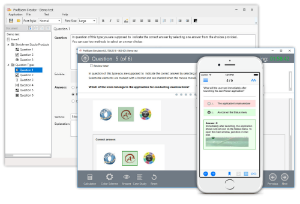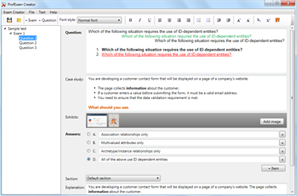File Info
| Exam | HCIP-Datacom-Core Technology V1.0 |
| Number | H12-821_V1.0 |
| File Name | Huawei.H12-821_V1.0.VCEplus.2025-04-02.71q.tqb |
| Size | 4 MB |
| Posted | Apr 02, 2025 |
| Download | Huawei.H12-821_V1.0.VCEplus.2025-04-02.71q.tqb |
How to open VCEX & EXAM Files?
Files with VCEX & EXAM extensions can be opened by ProfExam Simulator.
Coupon: MASTEREXAM
With discount: 20%
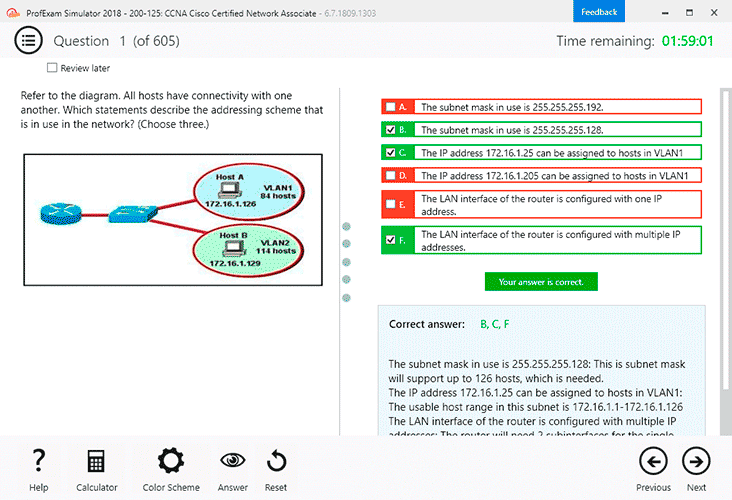

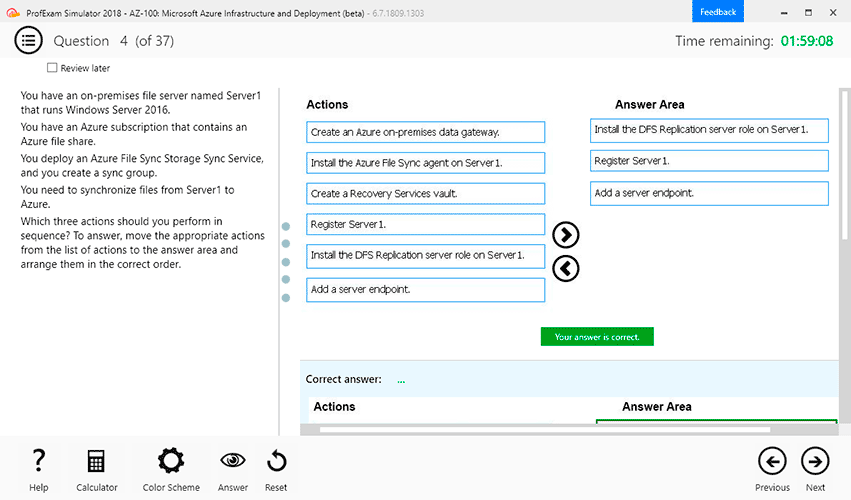
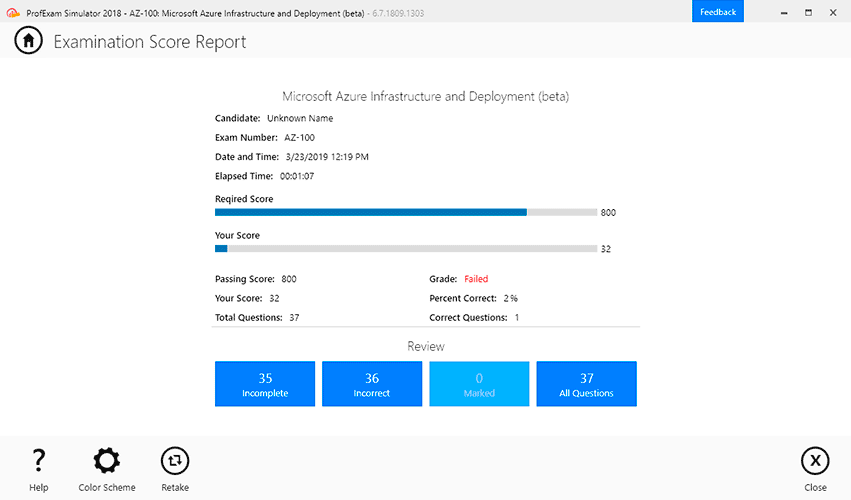
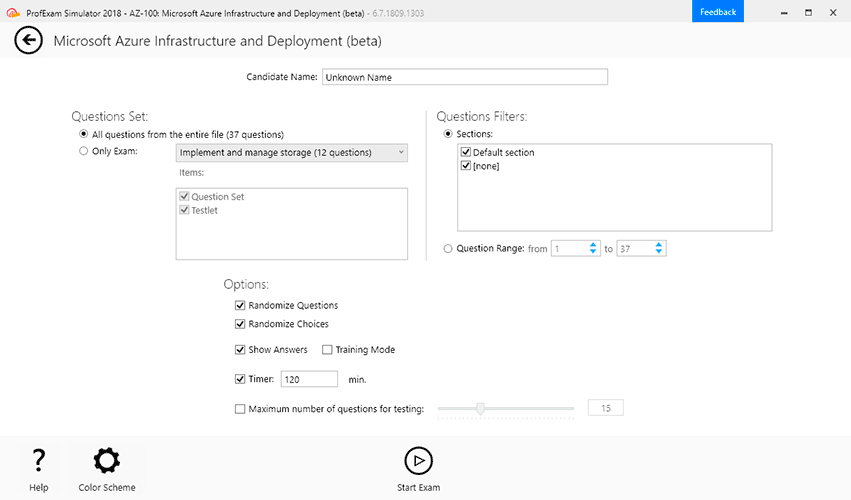

Demo Questions
Question 1
BFD for OSPF is deployed on a directly connected link. If the physical link is disconnected, drag the following BFD processes to the corresponding sequence numbers.
Correct answer: To work with this question, an Exam Simulator is required.
Question 2
The VRID of the VRRP virtual router is 3 and the virtual IP address is 100.1.1.10. What is the virtual MAC address?
- 01-00-5E-00-01-64
- 01-00-5E-00-01-03
- 00-00-5E-00-01-64
- 00-00-5E-00-01-03
Correct answer: D
Explanation:
The virtual MAC address for a VRRP virtual router is determined by the formula 00-00-5E-00-01-[VRID in hexadecimal]. For VRID 3, the hexadecimal equivalent is 03. Thus, the virtual MAC address is 00-00-5E-00-01-03 . The virtual MAC address for a VRRP virtual router is determined by the formula 00-00-5E-00-01-[VRID in hexadecimal]. For VRID 3, the hexadecimal equivalent is 03. Thus, the virtual MAC address is 00-00-5E-00-01-03 .
Question 3
During the DHCP interaction process, the DHCP server and client exchange various types of packets.
Which of the following packets is not sent from the client to the server?
- DHCP Release
- DHCPNAK
- DHCP Request
- DHCP Discover
Correct answer: B
Explanation:
The DHCPNAK message is sent by the DHCP server to the client to indicate that the requested configuration is not valid. Messages like DHCPDiscover, DHCPRequest, and DHCPRelease are initiated by the client in the DHCP process . The DHCPNAK message is sent by the DHCP server to the client to indicate that the requested configuration is not valid. Messages like DHCPDiscover, DHCPRequest, and DHCPRelease are initiated by the client in the DHCP process .
Question 4

Which of the following statement regarding the display ospf peer command output is true?

- Address: 10.1,1.1 Indicates that the local interface address is 10.1.1.1.
- Through negotiation during DD packet exchange, the local end becomes the slave.
- Router ID indicates that the local router ID Is 10.1.1.1.
- The DR address is 10.1.1.1
Correct answer: B
Explanation:
The command output indicates that the OSPF neighbor state is Full and that the neighbor relationship has been established. The statement confirms that the negotiation process during the exchange of DD (Database Description) packets has determined the role of the router, with the local device becoming the slave in the Master-Slave relationship, which is critical for LSA synchronization. The other options do not align with the output or OSPF principles The command output indicates that the OSPF neighbor state is Full and that the neighbor relationship has been established. The statement confirms that the negotiation process during the exchange of DD (Database Description) packets has determined the role of the router, with the local device becoming the slave in the Master-Slave relationship, which is critical for LSA synchronization. The other options do not align with the output or OSPF principles
Question 5
Huawei modular devices have multiple hardware modules that provide different functions. Match the following hardware modules with their functions.
Correct answer: To work with this question, an Exam Simulator is required.
Question 6
A router performs a lookup in its FIB table for a packet. If the tunnel ID in the matching entry is 0, the packet needs to be forwarded through a tunnel, such as an MPLS tunnel.
- TRUE
- FALSE
Correct answer: B
Explanation:
The question indicates that a router performs a lookup in its FIB table for a packet and determines that the tunnel ID in the matching entry is 0, suggesting that the packet needs to be forwarded through a tunnel such as an MPLS tunnel. However, this is a misunderstanding of the FIB functionality.FIB Table OverviewThe Forwarding Information Base (FIB) is used to make packet-forwarding decisions. Entries in the FIB include next-hop information, which can be directly linked to an interface or a tunnel.If the Tunnel ID is 0, it indicates that the packet is forwarded via a normal routing path and not through a tunnel.For MPLS or other tunnels, the Tunnel ID would have a non-zero value pointing to the associated tunnel.MPLS Tunnel OperationWhen a router forwards packets through an MPLS tunnel, a label-switched path (LSP) is set up. The FIB would reflect specific tunnel identifiers for packets that need such encapsulation.HCIP-Datacom-Core ReferenceRouting Principles and MPLSexplain the forwarding mechanisms clearly, stating that if a packet is routed normally, the tunnel ID remains 0.The section on MPLSclarifies the encapsulation process and the role of tunnel identifiers.Hence, the claim in the question is incorrect. A Tunnel ID of 0 implies no tunneling is required, and normal IP forwarding occurs The question indicates that a router performs a lookup in its FIB table for a packet and determines that the tunnel ID in the matching entry is 0, suggesting that the packet needs to be forwarded through a tunnel such as an MPLS tunnel. However, this is a misunderstanding of the FIB functionality.
FIB Table Overview
The Forwarding Information Base (FIB) is used to make packet-forwarding decisions. Entries in the FIB include next-hop information, which can be directly linked to an interface or a tunnel.
If the Tunnel ID is 0, it indicates that the packet is forwarded via a normal routing path and not through a tunnel.
For MPLS or other tunnels, the Tunnel ID would have a non-zero value pointing to the associated tunnel.
MPLS Tunnel Operation
When a router forwards packets through an MPLS tunnel, a label-switched path (LSP) is set up. The FIB would reflect specific tunnel identifiers for packets that need such encapsulation.
HCIP-Datacom-Core Reference
Routing Principles and MPLSexplain the forwarding mechanisms clearly, stating that if a packet is routed normally, the tunnel ID remains 0.
The section on MPLSclarifies the encapsulation process and the role of tunnel identifiers.
Hence, the claim in the question is incorrect. A Tunnel ID of 0 implies no tunneling is required, and normal IP forwarding occurs
Question 7
On an OSPF network, one router with P2P as the network type is directly connected to another router with P2MP as the network type. If the Hello intervals on the two routers are changed to be the same, neighbor relationship establishment and LSDB synchronization are not affected.
- TRUE
- FALSE
Correct answer: B
Explanation:
The scenario describes a mismatch in OSPF network types between two connected routers: one set to Point-to-Point (P2P) and the other set to Point-to-Multipoint (P2MP). While aligning Hello intervals may seem sufficient for establishing an OSPF neighbor relationship, the fundamental mismatch in network types introduces issues.OSPF Network TypesP2P: Assumes a direct connection with a single neighbor, uses faster convergence and simpler LSDB synchronization.P2MP: Supports multiple neighbors on a single interface, requiring different handling for DR/BDR roles and LSDB updates.Impact of Network Type Mismatch If Hello intervals are aligned, adjacency establishment might occur. However, mismatched network types affect neighbor role assignment and LSDB synchronization.P2P expects a direct link and would handle updates differently than P2MP, which assumes multiple neighbors. This leads to inconsistencies in route calculation and forwarding.HCIP-Datacom-Core ReferenceOSPF Basics and Configurationclearly outlines the criticality of consistent network type configuration for stable OSPF operation.Lab examples in the HCIP Datacom Lab Guidefurther demonstrate the consequences of such mismatches, including unstable neighbor states and incomplete LSDB synchronization.Hence, the statement that neighbor relationships and LSDB synchronization remain unaffected is incorrect. Proper OSPF operation requires matching network types in addition to aligned Hello intervals. The scenario describes a mismatch in OSPF network types between two connected routers: one set to Point-to-Point (P2P) and the other set to Point-to-Multipoint (P2MP). While aligning Hello intervals may seem sufficient for establishing an OSPF neighbor relationship, the fundamental mismatch in network types introduces issues.
OSPF Network Types
P2P: Assumes a direct connection with a single neighbor, uses faster convergence and simpler LSDB synchronization.
P2MP: Supports multiple neighbors on a single interface, requiring different handling for DR/BDR roles and LSDB updates.
Impact of Network Type Mismatch If Hello intervals are aligned, adjacency establishment might occur. However, mismatched network types affect neighbor role assignment and LSDB synchronization.
P2P expects a direct link and would handle updates differently than P2MP, which assumes multiple neighbors. This leads to inconsistencies in route calculation and forwarding.
HCIP-Datacom-Core Reference
OSPF Basics and Configurationclearly outlines the criticality of consistent network type configuration for stable OSPF operation.
Lab examples in the HCIP Datacom Lab Guidefurther demonstrate the consequences of such mismatches, including unstable neighbor states and incomplete LSDB synchronization.
Hence, the statement that neighbor relationships and LSDB synchronization remain unaffected is incorrect. Proper OSPF operation requires matching network types in addition to aligned Hello intervals.
Question 8
On an enterprise network, the directly connected interfaces of two OSPF routers are on different network segments and have different masks. To establish an OSPF neighbor relationship between the two interfaces, you can change their network types to which of the following?
- Point-to-point
- NBMA
- P2MP
- Broadcast
Correct answer: A
Explanation:
When OSPF routers have interfaces on different network segments with different subnet masks, the network type can be adjusted to establish adjacency. A point-to-point (P2P) network type eliminates the requirement for matching subnet masks by treating the link as directly connected without intermediate devices.P2P Network CharacteristicsOSPF treats the link as a direct connection between two routers.No DR/BDR election occurs, simplifying adjacency establishment.Subnet mask differences do not hinder neighbor relationships as the link is viewed as a logical tunnel.HCIP-Datacom-Core ReferenceThe OSPF configuration section explicitly mentions P2P as a suitable network type for resolving adjacency issues caused by mismatched subnet masks. When OSPF routers have interfaces on different network segments with different subnet masks, the network type can be adjusted to establish adjacency. A point-to-point (P2P) network type eliminates the requirement for matching subnet masks by treating the link as directly connected without intermediate devices.
P2P Network Characteristics
OSPF treats the link as a direct connection between two routers.
No DR/BDR election occurs, simplifying adjacency establishment.
Subnet mask differences do not hinder neighbor relationships as the link is viewed as a logical tunnel.
HCIP-Datacom-Core Reference
The OSPF configuration section explicitly mentions P2P as a suitable network type for resolving adjacency issues caused by mismatched subnet masks.
Question 9
On an OSPF network, an algorithm is used to prevent loops within an area, but loops may occur between areas. Therefore, OSPF defines a loop prevention mechanism for inter-area routes. Which of the following statements are true about the loop prevention mechanism?
- Inter-area routes cannot be directly transmitted between non-backbone areas.
- All non-backbone areas must be directly connected to area 0.
- Inter-area routes need to be forwarded through area 0.
- An ABR cannot inject Type 3 LSAs that describe routes to a network segment in an area back to the same area.
Correct answer: ABCD
Explanation:
OSPF Area Design and Loop Prevention:OSPF uses a hierarchical structure with areas to improve scalability and efficiency. Area 0, the backbone area, plays a crucial role in ensuring loop-free route distribution between areas. The following mechanisms are key to preventing routing loops:Strict adherence to hierarchical area design.Prohibition of direct inter-area route exchanges between non-backbone areas.Analysis of Each Statement:A . Inter-area routes cannot be directly transmitted between non-backbone areas.This statement is TRUE. OSPF mandates that all inter-area routing must pass through Area 0. Direct inter-area route exchanges between two non-backbone areas are not allowed to prevent loops. B . All non-backbone areas must be directly connected to area 0.This statement is TRUE. OSPF requires every non-backbone area to connect directly to Area 0 to facilitate loop-free inter-area routing. Virtual links may be configured in exceptional cases where direct connection is not possible.C . Inter-area routes need to be forwarded through area 0.This statement is TRUE. All inter-area traffic must traverse Area 0 to ensure hierarchical routing and loop prevention. This rule is a core design principle of OSPF.D . An ABR cannot inject Type 3 LSAs that describe routes to a network segment in an area back to the same area.This statement is TRUE. OSPF explicitly prohibits an ABR from injecting Type 3 LSAs describing a route into the same area where the route originates. This mechanism prevents routing loops within an area.Conclusion:All options (A, B, C, D) are correct. OSPF enforces a robust loop prevention mechanism through hierarchical routing, mandatory traversal via Area 0, and strict rules on LSA propagation by ABRs. This ensures reliable and loop-free inter-area routing in OSPF networks. OSPF Area Design and Loop Prevention:
OSPF uses a hierarchical structure with areas to improve scalability and efficiency. Area 0, the backbone area, plays a crucial role in ensuring loop-free route distribution between areas. The following mechanisms are key to preventing routing loops:
Strict adherence to hierarchical area design.
Prohibition of direct inter-area route exchanges between non-backbone areas.
Analysis of Each Statement:
A . Inter-area routes cannot be directly transmitted between non-backbone areas.
This statement is TRUE. OSPF mandates that all inter-area routing must pass through Area 0. Direct inter-area route exchanges between two non-backbone areas are not allowed to prevent loops.
B . All non-backbone areas must be directly connected to area 0.
This statement is TRUE. OSPF requires every non-backbone area to connect directly to Area 0 to facilitate loop-free inter-area routing. Virtual links may be configured in exceptional cases where direct connection is not possible.
C . Inter-area routes need to be forwarded through area 0.
This statement is TRUE. All inter-area traffic must traverse Area 0 to ensure hierarchical routing and loop prevention. This rule is a core design principle of OSPF.
D . An ABR cannot inject Type 3 LSAs that describe routes to a network segment in an area back to the same area.
This statement is TRUE. OSPF explicitly prohibits an ABR from injecting Type 3 LSAs describing a route into the same area where the route originates. This mechanism prevents routing loops within an area.
Conclusion:
All options (A, B, C, D) are correct. OSPF enforces a robust loop prevention mechanism through hierarchical routing, mandatory traversal via Area 0, and strict rules on LSA propagation by ABRs. This ensures reliable and loop-free inter-area routing in OSPF networks.
Question 10
OSPF has five types of packets, which have the same header format. If the Auth Type field in the packet header is 1, which of the following authentication modes is used?
- Non-authentication
- MD5 authentication
- Plaintext authentication
- Hash authentication
Correct answer: C
Explanation:
OSPF Authentication OverviewThe Auth Type field in the OSPF packet header determines the authentication mode. If the Auth Type is 1, plaintext authentication is used.Plaintext authentication involves transmitting the password in an easily readable format, which is less secure compared to MD5.HCIP-Datacom-Core ReferenceAuthentication mechanisms, including plaintext authentication, are detailed in the OSPF security configuration chapter, confirming that Auth Type = 1 corresponds to plaintext. OSPF Authentication Overview
The Auth Type field in the OSPF packet header determines the authentication mode. If the Auth Type is 1, plaintext authentication is used.
Plaintext authentication involves transmitting the password in an easily readable format, which is less secure compared to MD5.
HCIP-Datacom-Core Reference
Authentication mechanisms, including plaintext authentication, are detailed in the OSPF security configuration chapter, confirming that Auth Type = 1 corresponds to plaintext.
